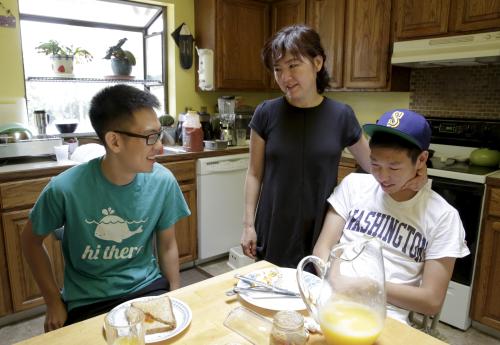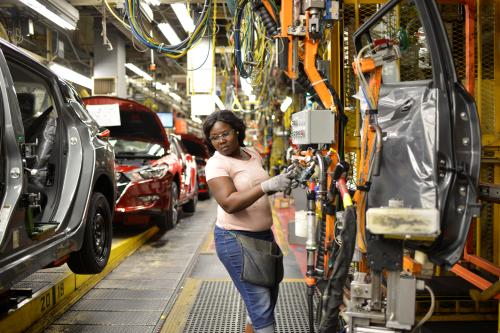This article originally appeared in the Guardian on June 5, 2019, as part of the Guardian series on Broken Capitalism.
The capitalist system in the US today is ruthless, delivering exceptionally uneven outcomes to people across the education and income distribution. These disparities translate into vastly different levels of childhood resources and experiences. The result is that a child’s socioeconomic class at birth has a tremendous influence on his or her life trajectory. If our capitalist system is going to be fair to children and families – if it is going to hold out any meaningful promise of equal opportunity – then a new social contract is needed.
Government cannot promise equal outcomes to children, but it can promote equal opportunities. This is achieved through the provision of public goods and services, including safety net supports and quality educational institutions. Children should have the opportunity to rise as far as their talents and work will take them. Individual hard work will earn material comfort; with talent and some luck, it might even earn great riches. And all children should have that opportunity. At least that’s how we imagine it’s supposed to work.
But in our modern capitalist society – characterized by tremendously high rates of income inequality, regional and local disparities, and extreme cultural and institutional divides – children from different family backgrounds do not have anything close to equal opportunities.
Children born to highly educated, high-income parents are almost all being raised in high-resource, two-parent homes. They live in safe neighborhoods with well-funded schools attended by high test-scoring peers. They almost all graduate high school and enroll in college, and a majority of those in college graduate with a degree. In contrast, children born to less educated, lower-income parents are increasingly being raised in single-parent homes with fewer resources. They often live in low-income neighborhoods and attend inferior schools. They graduate high school at much lower rates, and those who do enroll in college are much more likely to enroll in non-selective schools and much less likely to earn a degree.
Our country needs a new social contract, established with the aim of closing these class gaps in opportunity and ultimately outcomes. This will require a more complete social insurance system for children, improved educational institutions and stronger families.
Social insurance system for children
Roughly one in six children in America are living in poverty today. About 15 million children are living in households that are food insecure. That means millions of children are arriving at school each day with the pangs of hunger and other associated ills of poverty. Research from a variety of disciplines makes it clear that early life deprivation of various kinds has lasting negative effects on a child’s health, educational outcomes and ultimately their ability to work and earn high wages as an adult. On both moral and economic grounds, we need to do more in this country to ameliorate childhood deprivation.
We need a much stronger support system for low-income families. Specifically, the government should maintain and expand existing programs that are working well. It should also expand the safety net to fill in existing holes. In the US, this means expanding the Earned Income Tax Credit (EITC); maintaining the Supplemental Nutritional Assistance Program (Snap) and Medicaid entitlement programs; dramatically expanding funding for housing and childcare assistance for low-income families; and offering more support for parents who are out of work.
The EITC subsidizes the annual earnings of low-income workers. It gives the most help to those with two or more children, and plays a pivotal role in reducing poverty rates among families with children. The EITC is favored across the political aisle because it both encourages work and reduces poverty. Two enhancements should be made: increase the credit for families with only one child and for those with married families with two earners (who see less of a benefit from the program due to the way the US tax code treats two-earner families).
Next, food assistance and public health insurance for low-income families must be protected. There is a policy movement to make Snap and Medicaid contingent upon an individual’s steady hours of work. This would be a terrible mistake. Snap provides a monthly credit to millions of qualifying low-income families that they can use to purchase nutritious food. Snap lifts nearly 5 million people out of poverty, including more than 2 million children. Medicaid provides health insurance coverage to approximately 37 million low-income children, roughly half of all children in the United States. Both Snap and Medicaid not only help families in the short term, they lay the foundations for children to do better in the long run.
Denying poor children food stamps and health insurance because their parents cannot maintain steady employment would defy the very purpose of a safety net. It would also be morally cruel and economically counterproductive. Furthermore, there is no compelling evidence showing that access to these programs is damaging employment rates.
A system of social insurance to children should also provide for safe housing. In addition to food and healthcare, children need a home – a decent, stable place to live. It should never cease to shock us that, on any given night in this nation of great wealth, there are roughly 500,000 people experiencing homelessness, including more than 180,000 people in families with children. Many more children live in crowded, unsafe living conditions and can thus hardly be expected to thrive in school and reach their full human potential. Compelling evidence documents the benefits to children of moving out of high-poverty housing projects and neighborhoods.
Current federal spending on housing assistance programs is woefully inadequate. The federal government allocates less than $20bn a year to the Housing Choice Voucher Program, which is the largest federal program providing housing assistance to low-income families. There are far more eligible families than there are available vouchers, and as a result more than 17 million eligible renter households do not receive a voucher, including more than 6 million families with children under age 18. Millions of eligible families are placed on multi-year-long waiting lists for housing assistance, with some never receiving program benefits. Contrast this level of spending with the $130bn in annual tax expenditures attributed to tax deductions for mortgage interest payments and property taxes, which disproportionately benefit high-income home owners. On both equity and efficiency grounds, maintaining this tax break while underfunding housing assistance to low-income families makes no sense.
Millions of families also struggle to afford high-quality childcare. Just as there is no entitlement to housing or housing assistance in the US, there is no entitlement to childcare or childcare assistance. The Child Care and Development Fund, a federal and state partnership program, offers financial assistance to low-income families to access childcare so they can work or attend a job training or educational program. But with only $5bn in federal funding, this program does not have sufficient resources to help all eligible families. A recent estimate suggests that only one out of 10 of the roughly 12.7 million qualifying children are aided through this fund. Too many working parents are left with no choice but to leave their children in informal childcare arrangements of questionable quality. This gaping hole in the US system of support for working families is counterproductive to both the goal of increasing employment and the goal of fostering positive child development.
The final cornerstone of an expanded social insurance system for children is more help for out-of-work parents. Since the landmark 1996 welfare reform legislation, federal transfer programs provide very little aid by way of cash assistance to non-working adults. The only federal program that provides cash income to non-elderly, non-disabled individuals is Temporary Assistance to Needy Families (TANF). But benefits are time-limited and usually conditional on work requirements. To make matters worse, most states are only spending a small share of TANF dollars on cash assistance. The number of poor families receiving welfare benefits has plummeted since 1996, falling to roughly one-quarter in recent years. And the caseload hardly increased at all during the Great Recession, despite the surge in joblessness and economic insecurity. Our set of safety net supports should do much more to help out-of-work parents not only provide for their families, but also invest in themselves and their work capacity.
Improved educational institutions
Providing a strong social insurance system for our children should be the first obligation of government under a new social contract. The second is to provide a more robust set of educational institutions. Capitalism handsomely rewards those with high levels of skills and ingenuity. But those with lower levels of education and skill are being left further and further behind. It is more important than ever that all children have access to a high-quality education, from early childhood through adulthood.
By the time children arrive in kindergarten, there are huge gaps in academic and school preparedness between children from low-income and high-income families. Children from high-income families are much more likely to have benefited from parental educational investments, including prolific reading and talking engagement, as well as from participating in a formal preschool setting. Only about half of four-year-old children from families in the lowest income quintile attend preschool, compared to more than three-quarters of those from families in the highest income quintile.
Children are being done tremendous disservice by having no entitlement to education until the age of five. High-quality early childhood education should be available to all children, not just those lucky enough to win a lottery spot in an underfunded local program or to have parents who are able to pay for private early childhood education. Access to high-quality preschool programs for low-income children can yield large, lasting payoffs in terms of improved education and labor market outcomes.
Primary and secondary schools in the US are vastly unequal across our residentially segregated neighborhoods. Far too often, our system of neighborhood schools relegates children from poor neighborhoods into inferior schools. Decades of experimentation with incremental school reform has yielded few compelling solutions. School choice has in some instances led to better outcomes for some students, but has generally not led to widespread system improvements. The introduction of charter schools has led to the creation of some highly effective schools that serve some students quite well; others have proved disappointing.
Teachers matter. Students who have the good fortune of being assigned to a classroom with a high-quality teacher are more likely to graduate college and earn higher wages in later life. But there is not much policy evidence about how to successfully improve teacher quality or how to identify, recruit and retain good teachers. This is an area that warrants dedicated research and policy focus.
Beyond primary and secondary education, the ideal government in a capitalist society will promise students access to well-funded, effective post-secondary institutions of education and training. Given the tremendous importance of a college degree to economic outcomes in today’s capitalist system, it is imperative that more students complete college. A majority of high school graduates now enroll in college, but fewer than one-third of young adults actually complete a college degree. Completion rates are especially low among students from low-income families and at non-selective institutions. Money matters here: increased school funding and expanded student supports have been shown to lead to increased completion rates.
Federal and state governments should commit to dramatically expanded public funding of public universities and community colleges. These are the engines of social mobility in this country. The promise to students should be that if you are willing to work hard and pursue post-secondary studies and programs, then in return for your tuition payment – whether it be privately or publicly financed – you can expect to develop meaningful skills that will be rewarded in the labor market.
In addition, governments and school districts should continue developing and improving initiatives such as Career and Technical Education (CTE)programs that provide meaningful alternative pathways to successful employment.
Strengthened families
It is up to the government to meet the terms of the social contract through the creation of both a social insurance system and an improved educational system. But parents need to uphold their side of the bargain, too. There is only so much that public funds and public schools can do to make up for deficits in the home environment. We cannot ignore the role that family background and family structure play in shaping children’s life trajectory.
As I have argued, the government can and should do more to mitigate the material gaps between families of difference backgrounds. But parents are also making decisions that differ greatly across socioeconomic classes in ways that exacerbate inequality.
Today, fewer than two in three children are being raised in two-parent homes. This matters, because having only one parent in the home means fewer resources and less parental time investment. There is a big class divide here. Eighty-five per cent of children whose moms have a college degree live in a two-parent home, compared with 60% or lower of children born to a mother without a college degree.
Families headed by a single mother are five times more likely to live in poverty: 36% versus 7%. Being born to an unmarried parent is an important predictor of whether a child will be raised in poverty, drop out of high school and live in poverty as an adult. The link between poverty and single-parent families runs both ways, of course: living in poverty is a leading predictor of whether someone will become an unmarried parent. This makes it hard to precisely parse out causality. But, recent work by economists suggests that boys suffer even more than girls do when they are raised in a single-mother home, and that this might be contributing to boys’ relatively worse performance in school.
There is no easy solution to this challenge. But we cannot have an honest dialogue about children’s outcomes without acknowledging the role that family structure is playing in perpetuating class divides.
Many parents will need to do more to provide a secure, stable family life for their children. For some, this might mean delaying childbearing until they are in a more stable relationship and/or secure economic position. A terrific development in this regard is the tremendous decline in teen births over recent decades. Programs that promote affordable access to effective birth control have been shown to effectively lead to lower rates of teen and unplanned pregnancies. As to marriage, of course there are some parent unions that are harmful and should not remain intact. But initiatives that effectively encourage and support healthy marriages, or foster more father involvement in children’s lives regardless of parental marital status, will put children on a more reliable path toward upward mobility. Unfortunately the evidence on what types of policies and programs effectively strengthen families is thin.
Not all our social problems can be solved through public policy. Private decisions and commitments matter, too. For obvious reasons it is hard for governments to promote good parenting, stable families and healthy relationships – all of which are vital for child wellbeing, and opportunity. This part of the social contract has to be delivered, in large part, by individuals and communities.
A capitalism that works for children, and for the future, is both possible and desirable. But it will require a new social contract, a contract that places obligations on government and citizens alike. The responsibility lies with us all.







Commentary
Op-edTo thrive, American children need a stronger safety net
June 7, 2019